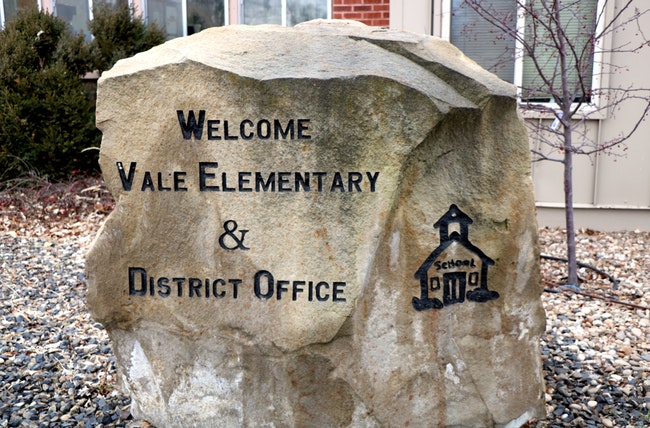 Vale School District office. (The Enterprise/File)
Vale School District office. (The Enterprise/File)
VALE – The water at Willowcreek Elementary School is contaminated with E. coli, and school district officials are currently weighing options for corrective action presented by the state health authority.
Health officials confirmed the presence of E. coli, a dangerous strain of bacteria that indicates fecal contamination in water, according to a letter the Oregon Health Authority sent to Willowcreek Elementary in September.
Currently, there is a “do not drink” advisory for the school, which will not be lifted until the water source for the school is free of microbiological contamination.
Alisha McBride, Vale School District superintendent, said that while there is no indication that anyone at the elementary school has fallen ill due to the contaminated water, students and faculty have been drinking from 5-gallon water dispenser jugs.
Bill Goss, regional engineer with the state Public Health Division, said that the county’s Environmental Health Department is helping ensure that the water served at the school is safe.
At a recent Vale School District board meeting, McBride updated the board on the E. coli situation, pointing out that the water well used at the school had never been registered with the state.
Goss said that the Willowcreek well does not have a driller’s log, meaning, the health authority doesn’t know how or when the well was constructed.
The state said in a corrective action plan sent to McBride that lack of a driller’s log means “the well’s construction is considered inadequate.”
The corrective action plan provided three options and set a deadline of Dec.13 for school officials to advise which route they were taking.
The deadline either “to have completed corrective action or be in compliance with an approved corrective action plan with a reasonable timeline” was Monday, Jan. 20.
The options include eliminating the source of the contamination, providing another source of water, or reconstructing the well to meet standards.
McBride said that the district has chosen to reconstruct the current well, and that it has until August to complete the project.
“I am hopeful that the situation will be remedied much before that time,” McBride said.
“There are several potential sources of contamination in the area,” Goss said of the Willowcreek well.
Some of these sources include the school’s own septic system and drainage field, as well as a nearby pond that would likely test positive for E. coli.
“It is very difficult to pin down where it is coming from,” Goss said.
[ KEEP YOUR LOCAL NEWS STRONG – SUBSCRIBE ]
“The school district is responsible for serving safe water and our oversight ensures that it is safe water,” Goss said.
However, Goss said, because the water system at the school is chlorinated, there was some level of protection from bacteria.
McBride said that after considering the options, drilling a new well is the best for the district.
According to Julie Harvey, a drinking water specialist at the Oregon Department of Environmental Quality, there are only a “handful” of instances of fecal contamination in the state and that it is something to be taken seriously.
“Fecal contamination includes harmful bacteria and viruses that have the potential to cause serious gastrointestinal illness,” the Health Authority wrote in its confirmation letter. “Water containing E. coli is considered unsafe to drink.”
Goss said that the Health Authority requires water systems that chlorinate, such as the Willowcreek system, to take an untreated sample from its well once a year.
The annual testing for Willowcreek occurred on Sept. 11, the results indicating the presence of E. coli.
However, “we never just go by one test result though because we want to make sure there wasn’t a problem with the way the sample was collected,” Goss said.
After doing what is called “confirmation samples,” Goss said, two of those samples tested positive for E. coli.
Goss said that in regulated water systems that the Health Authority works with, E. coli contamination is infrequent.
“We might get across the state six to eight cases of that a year,” he said.
What makes E. coli so dangerous, Harvey said, is that it causes illness a lot faster than, for example, arsenic, which causes illness over time.
Goss said that some telltale signs of E. coli sickness are nausea, cramping and diarrhea, and that it only takes one glass of contaminated water to bring on symptoms.
Goss said that in smaller communities such as Nyssa and Vale, it is harder to ensure the quality of drinking water.
“You only have a few thousand people to bear the cost, instead of a larger city where you can spread the cost between tens of thousands of people,” Goss added.
News tip? Contact reporter Joe Siess: [email protected] or 541-473-3377.
For the latest news, follow the Enterprise on Facebook and Twitter.
SUBSCRIBE TO HELP PRODUCE VITAL REPORTING — For $5 a month, you get breaking news alerts, emailed newsletters and around-the-clock access to our stories. We depend on subscribers to pay for in-depth, accurate news produced by a professional and highly trained staff. Help us grow and get better with your subscription. Sign up HERE.




